Copyright 2011, 2014 by Janet Cooper All Rights Reserved. No part of this book may be reproduced in any manner without the express written consent of the publisher, except in the case of brief excerpts in critical reviews or articles. All inquiries should be addressed to Skyhorse Publishing, 307 West 36th Street, 11th Floor, New York, NY 10018. Skyhorse Publishing books may be purchased in bulk at special discounts for sales promotion, corporate gifts, fund-raising, or educational purposes. Special editions can also be created to specifications. For details, contact the Special Sales Department, Skyhorse Publishing, 307 West 36th Street, 11th Floor, New York, NY 10018 or .
Skyhorse and Skyhorse Publishing are registered trademarks of Skyhorse Publishing, Inc., a Delaware corporation. Visit our website at www.skyhorsepublishing.com. 10 9 8 7 6 5 4 3 2 1 Library of Congress Cataloging-in-Publication Data available on file. Cover design by Jane Sheppard Cover photo credit Janet Cooper ISBN: 978-1-62914-226-5 E-book ISBN: 978-1-62914-267-8 Printed in China In memory of Mary Elizabeth, who taught Blanche, who taught me  CONTENTS
CONTENTS  AUTHORS NOTE
AUTHORS NOTE  T his book is intended for the beginning, as well as the experienced, canner who wants to extend the pleasures of pickling, preserving, and making unusual taste treats of all sorts in small batches during any time of the year. A good portion of the recipes can be refrigerated instead of being sealed in jars, which is a boon especially in the winter months when canning supplies are often difficult to find. All of these recipes will provide you with tasty and unusual treats that are perfect to give as gifts.
T his book is intended for the beginning, as well as the experienced, canner who wants to extend the pleasures of pickling, preserving, and making unusual taste treats of all sorts in small batches during any time of the year. A good portion of the recipes can be refrigerated instead of being sealed in jars, which is a boon especially in the winter months when canning supplies are often difficult to find. All of these recipes will provide you with tasty and unusual treats that are perfect to give as gifts.
It should be noted that many of the recipes can be safely altered to reflect your own individual taste and preferences. I hope you enjoy expanding your canning and preserving experiences through these small-batch recipes. EQUIPMENT YOU WILL NEED  M ost of the recipes in this collection can easily be made with equipment already in your kitchen but you may want to add a few tools as you go along. Below is a list of the most commonly needed equipment in order to successfully can and preserve just about everything in this book: Measuring spoonsmetal works best. Measuring cups in 1-, 2-, and 4-cup sizesglass is handiest for measuring liquids and can go in the microwave if necessary. Metal cups are good for sugar and solids.
M ost of the recipes in this collection can easily be made with equipment already in your kitchen but you may want to add a few tools as you go along. Below is a list of the most commonly needed equipment in order to successfully can and preserve just about everything in this book: Measuring spoonsmetal works best. Measuring cups in 1-, 2-, and 4-cup sizesglass is handiest for measuring liquids and can go in the microwave if necessary. Metal cups are good for sugar and solids.
Tongsused to remove boiled jars and lids from boiling water. Wide-mouthed funnelto fit a standard canning jar, preferably metal. Sharp knivesbuy the best you can afford and also a good sharpener. Spoonsan assortment of wood and metal; a flat-ended wooden spoon is a great help when stirring a hot bubbling pot, and a slotted spoon is also useful for straining. For breaking up hard spices, such as cinnamon sticks and pepper corns, a tool such as a metal meat-tenderizing mallet will help. A hammer covered with a cloth will work too.
Vegetable brushkeep it just for food use. Graterone with a variety of hole sizes. Juicer Ladle for filling jarsa long-handled measuring cup or a teacup will work as a substitute but remember, it will get hot. Jar lid tightenera variety of them is on the market from a useful nonslip pad to a metal gripper. Hot pads Dishcloths Hand and dish towels Apronboiling kettles do spit and fruit juices will stain your clothing. Paper towels Cheesecloth or muslin and string to make spice bags.
A tea caddy will make a good substitute, but you may not want to use it for tea again. Jelly bagthe corner of an old pillowcase works well. Bowlsa variety of sizes in glass, plastic, or stainless steel. Saucepansstainless steel with a good heavy bottom is best since thin-bottomed pans stick. Aluminum pans will pit from the acid in many foods. Colandersuch as you would use to drain pasta.
Diffusera variety is available and will be a big help in avoiding stuck and burned mixtures.  Chopping boardchoose one that is easy to keep clean. Timer Thermometera candy thermometer that clips to the side of the pan is best. An assortment of crocks, plastic tubs, small plastic buckets, and stone jars as needed. Kettlesheavy-bottomed stainless steel is best; aluminum will work but acid mixtures will pit it. Never use cast iron or chipped enamel.
Chopping boardchoose one that is easy to keep clean. Timer Thermometera candy thermometer that clips to the side of the pan is best. An assortment of crocks, plastic tubs, small plastic buckets, and stone jars as needed. Kettlesheavy-bottomed stainless steel is best; aluminum will work but acid mixtures will pit it. Never use cast iron or chipped enamel.
A 4- to 6-quart kettle will handle most of these recipes. Conventional strainers in various sizes with a fine mesh. Large strainer on a stand with a pestle to force food through or a food mill. Food grindera metal grinder with a variety of blades works well. A food processor will work but it is hard to control and get evenly ground food. Many stand mixers have a grinder attachment that will work well too.
Blender or food processorfor pureeing mixtures. For a smooth puree, a blender or food processor will work best. If you want more texture, a handheld immersion blender works very well, and for even more texture, a potato masher will often be sufficient. Canning jars in a variety of sizesstandard canning jars, also known as Mason jars, come in 8 oz. half pints, 16 oz. quarts. quarts.
A few other sizes are occasionally available but these are the most commonly used sizes. You will need these for long-term sealed storage, so buy whatever size you think suits your uses. Pints and quarts also come with standard-size tops and wide-mouth tops. Choose whichever you like. When you purchase your jars, they will come with a removable rim and an inner sealer or lid, which will stay attached to the jar until it is opened for use. The lids should not be reused but the rims can be used many times before being replaced.
Replacement lids and rims are readily available at stores selling canning supplies. You may reuse jars and their lids from commercially canned foods that are not standard sizes if they are to be kept in the refrigerator. Kitchen supply stores often sell attractive containers in a variety of size and shapes. They cannot be sealed but will be nice for gifts. INGREDIENTS  I ngredients are listed at the beginning of each recipe. Be sure to read completely through a recipe to make sure you have everything needed.
I ngredients are listed at the beginning of each recipe. Be sure to read completely through a recipe to make sure you have everything needed.
Remember: your results can be no better than your ingredients, so a few important things to remember are included here. Produce : Use only the freshest available, store it carefully, and use as soon as possible. Fruits should be just ripe, not soft, and vegetables crisp and firm. Vinegar : Do not try to make your own for canning. Vinegar is a preservative and must be 4 to 5 percent acid to be effective. Some of these recipes call for white vinegar and some for cider vinegar.
Each will give a distinctive color and taste but usually can be used interchangeably as personal taste dictates. Salt : This is also a preservative, so use pure non-iodized canning or kosher salt. Table salts have iodine and additives to prevent lumping that will result in cloudy syrups. Wherever salt is used in this book, it is understood to be coarse canning or kosher salt. Spices : Spices will not go bad over time; they will just lose some flavor when kept too long. Whole spices have a longer shelf life than ground.

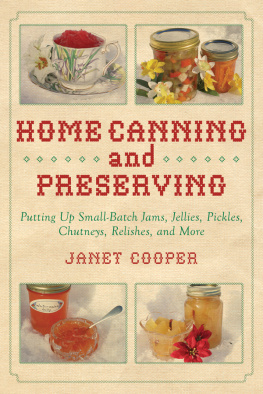
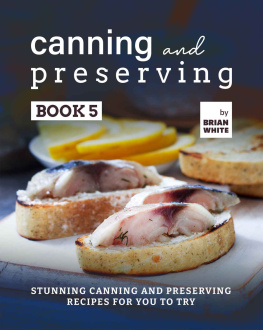
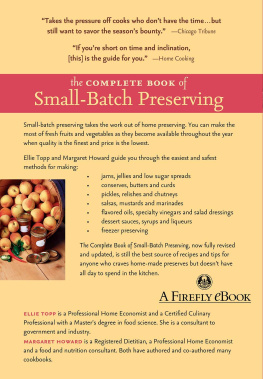
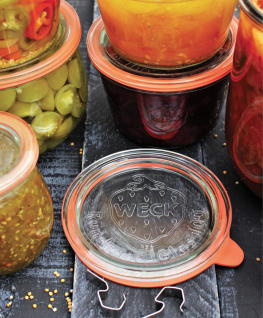

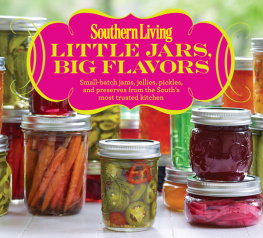
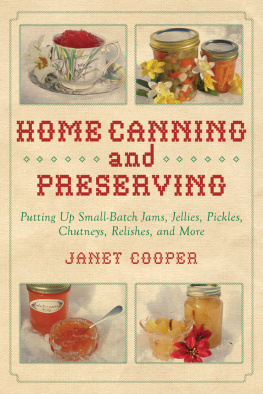
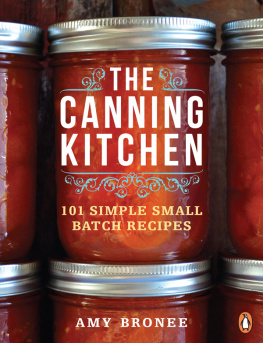

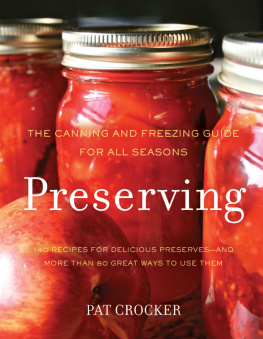

 CONTENTS
CONTENTS  AUTHORS NOTE
AUTHORS NOTE  T his book is intended for the beginning, as well as the experienced, canner who wants to extend the pleasures of pickling, preserving, and making unusual taste treats of all sorts in small batches during any time of the year. A good portion of the recipes can be refrigerated instead of being sealed in jars, which is a boon especially in the winter months when canning supplies are often difficult to find. All of these recipes will provide you with tasty and unusual treats that are perfect to give as gifts.
T his book is intended for the beginning, as well as the experienced, canner who wants to extend the pleasures of pickling, preserving, and making unusual taste treats of all sorts in small batches during any time of the year. A good portion of the recipes can be refrigerated instead of being sealed in jars, which is a boon especially in the winter months when canning supplies are often difficult to find. All of these recipes will provide you with tasty and unusual treats that are perfect to give as gifts. Chopping boardchoose one that is easy to keep clean. Timer Thermometera candy thermometer that clips to the side of the pan is best. An assortment of crocks, plastic tubs, small plastic buckets, and stone jars as needed. Kettlesheavy-bottomed stainless steel is best; aluminum will work but acid mixtures will pit it. Never use cast iron or chipped enamel.
Chopping boardchoose one that is easy to keep clean. Timer Thermometera candy thermometer that clips to the side of the pan is best. An assortment of crocks, plastic tubs, small plastic buckets, and stone jars as needed. Kettlesheavy-bottomed stainless steel is best; aluminum will work but acid mixtures will pit it. Never use cast iron or chipped enamel.